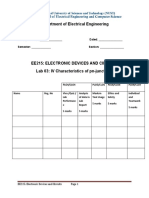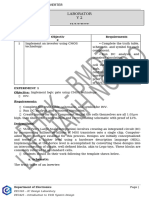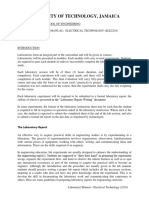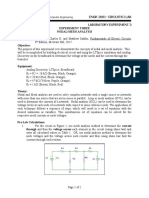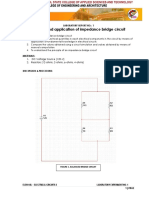Lab 4
Lab 4
Uploaded by
noshairwankhan667Copyright:
Available Formats
Lab 4
Lab 4
Uploaded by
noshairwankhan667Copyright
Available Formats
Share this document
Did you find this document useful?
Is this content inappropriate?
Copyright:
Available Formats
Lab 4
Lab 4
Uploaded by
noshairwankhan667Copyright:
Available Formats
Department of Electrical Engineering
Faculty Member: ____________________ Dated: ________________
Semester: __________________________ Section: ________________
EE-111: Linear Circuit Analysis
Lab 4: NODAL ANALYSIS
PLO4/CLO5 PLO5/CLO6 PLO8/CLO7 PLO9/CLO8
Name Reg. No Viva /Quiz / Analysis Modern Ethics and Safety Individual and
Lab of data in Tool Usage Teamwork
Performance Lab 5 marks
Report 5 marks 5 marks
5 marks
5 marks
EE-111: Linear Circuit Analysis Page 1
Lab 4: NODAL ANALYSIS
Introduction
This laboratory execise is meant to enble the students to accomplish nodal analysis
of simple circuits and correlate measured vaues with the theoretical calculations of
voltages and currents through various circuit elements.
Objectives
The following are the broad objectives of this lab:
Circuit setup on bread board.
Calculate the currents and voltages in the valarious circuit elements.
Use the DMM as a ammeter and voltmeter to measure the various currents
and voltages.
Explain deviations in results in case these are encountered during the
experiment.
Conduct of Lab
The students are required to work in groups of three to four; each student must
attempt to understand and use the laboratoy set-up and conduct at least one or two
parts of the requirement experimentation. The lab engineer will be available to assit
the students.
In case some aspect of the lab experiment is not understood the students are
advised to seek help from the teacher, the lab engineer.
Lab Equipment
The following equipment would be used in this experiment:
Test test bench
The Multimeter
The Power Supply
Digital Multimeter
Pre-lab:
Before coming to the lab, students must study and practice the node-voltage
method. Also review the theoretical concepts relating Kirchhoff’s voltage and
current laws.
NODE-VOLTAGE METHOD:
The node-voltage method uses KCL equations that are written at all non-
reference nodes. Recall that KCL states that the sum of all the currents at a node is
zero. The node-voltage method is comprised of the following steps:
1. Identify all the nodes in a circuit.
2. Choose one of the nodes as the reference node (usually a low potential node).
EE-111: Linear Circuit Analysis Page 2
3. Assign variable names to each of the essential (non-reference) nodes. Mark
voltages as per the variable names assigned to each node e.g. va, vb, vc, etc.
4. Determine the direction of currents i.e. mark voltage polarities across each
circuit element.
5. Write a KCL equation in terms of node-voltages at each of the non-reference
nodes. The result will be (n-1) equations where n is the number of essential nodes
plus a reference node.
1) Circuit for Analysis by Nodal Analysis Method.
a) For the circuit given below use NODAL ANALYSIS to measure and calculate all
the currents and voltages for each circuit element.
The first step is to calculate the values of currents ,to accomplish do the
following.
i) Measure all the currents and voltages.
ii) Caluculate the power delivered /absorbed by each circuit element.
iii) Write thefinal set of equations necessary to calculate the currents.
iv) Fill in TABLE 1a & 1b.
I3 I5
I2
IA I4 IB
I1
CAUTION
DO NOT SWITCH ON POWER TILL YOU
FIGURE 1 HAVE GOTTEN YOUR CIRCUIT
CHECKED BY YOUR LAB INSTRUCTOR
note : must show calculations ( for calculations use back side of the page or
separate sheet if required )
EE-111: Linear Circuit Analysis Page 3
THEORETICAL CALCULATIONS:
S.N ELEMEN VOLTAGE CURRENT POWER
O T ABSORBE
CALCULATE MEASURED CALCULATED MEASURE DDELIVE
D D RED
1 V1
2 R1
3 R2
4 R3
5 R4
6 R5
7 V2
TABLE 1a
b) Now simulate the above circuit in PSpice and record the values of voltages and
currents in the table below and find out the percentage deviation in the
measured and simulated values.
c) By using the printscreen option save the simulation in a folder on the desktop.
EE-111: Linear Circuit Analysis Page 4
S.N ELEMEN VOLTAGE CURRENT %age
O T DEVIATIO
SIMULATED MEASURED SIMULATED MEASURE N
D
1 V1
2 R1
3 R2
4 R3
5 R4
6 R5
7 V2
TABLE 1b
d) Explain any discrepancies between the calculated and measured values
_________________________________________________________________________________
___________________________________________________________________________
_________________________________________________________________________________
___________________________________________________________________________
_________________________________________________________________________________
___________________________________________________________________________
2) Circuit For Analysis using Super Node Concept..
a) For the circuit given below use SUPER NODE CONCEPT calculate all the
currents and voltages for each circuit element.
EE-111: Linear Circuit Analysis Page 5
Set up the circuit give below and do the following:
i) Measure all the currents and voltages.
ii) Caluculate the power delivered /absorbed by each circuit element.
iii) Fill in TABLE 2a and 2b.
CAUTION
FIGURE 2 DO NOT SWITCH ON POWER TILL YOU
HAVE GOTTEN YOUR CIRCUIT CHECKED
BY YOUR LAB INSTRUCTOR
THEORETICAL CALCULATIONS:
EE-111: Linear Circuit Analysis Page 6
S.N ELEMEN VOLTAGE CURRENT POWER
O T ABSORBED
CALCULATE MEASURE CALCULATE MEASURE /DELIVERE
D D D D D
1 V1
2 R1
3 R2
4 R3
5 R4
6 R5
7 R6
8 V2
9 V3
TABLE 2a
b) Now simulate the above circuit in PSpice and record the values of voltages and
currents in the table below and find out the percentage deviation in the
measured and simulated values.
c) By using the printscreen option save the simulation in a folder on the desktop.
EE-111: Linear Circuit Analysis Page 7
S.N ELEMEN VOLTAGE CURRENT %age
O T DEVIATIO
SIMULATED MEASURE SIMULATED MEASURE N
D D
1 V1
2 R1
3 R2
4 R3
5 R4
6 R5
7 R6
8 V2
9 V3
TABLE 2b
a) Explain any discrepancies between the calculated and measured values
_________________________________________________________________________________
___________________________________________________________________________
_________________________________________________________________________________
___________________________________________________________________________
_________________________________________________________________________________
___________________________________________________________________________
_________________________________________________________________________________
___________________________________________________________________________
EE-111: Linear Circuit Analysis Page 8
3. Considering the time it took to measure the values of voltage and
current across the elements, and the time it took to perform nodal
analysis on paper, would you agree that nodal analysis is an effective
circuit analysis technique? Explain
_____________________________________________________________________________________
_____________________________________________________________________________
_____________________________________________________________________________________
_____________________________________________________________________________
_____________________________________________________________________________________
_____________________________________________________________________________
_____________________________________________________________________________________
_____________________________________________________________________________
_________________________________________________________________________________
4. You have several 1KΩ and 6KΩ resistors. You are required to design a
circuit using four resistors and a 5V power supply to provide 2V at the
outputs. Note: The output will be taken across the resistor(s).
5. Please explain briefly what you have learned in this lab and any
difficulties you encountered
_________________________________________________________________________________
___________________________________________________________________________
EE-111: Linear Circuit Analysis Page 9
You might also like
- Department of Electrical Engineering: Faculty Member: - DatedDocument15 pagesDepartment of Electrical Engineering: Faculty Member: - DatedOk BabyNo ratings yet
- University Malaysia Perlis: Electric Circuit TheoryDocument7 pagesUniversity Malaysia Perlis: Electric Circuit TheoryRomulo TuiqalauNo ratings yet
- (Razavi) Design of Analog Cmos Integrated CircuitsDocument21 pages(Razavi) Design of Analog Cmos Integrated CircuitsNiveditha Nivi100% (1)
- Department of Electrical Engineering: Nukhba Amir Shameen Mazhar Maryam ShafeeqDocument14 pagesDepartment of Electrical Engineering: Nukhba Amir Shameen Mazhar Maryam ShafeeqAsma GulzarNo ratings yet
- Lab 2Document9 pagesLab 2Ahmed Razi UllahNo ratings yet
- Lab01 Solution01Document9 pagesLab01 Solution01Abdul Hannan AdilNo ratings yet
- LAB AssignmentDocument4 pagesLAB AssignmentAlwani IzzatiNo ratings yet
- Lab 4 ReportDocument8 pagesLab 4 Reportrervin2No ratings yet
- Report 2Document8 pagesReport 2Ahmed Razi UllahNo ratings yet
- Lab 03Document11 pagesLab 03afnanmirza106No ratings yet
- Lab 3Document10 pagesLab 3Ahmed Razi UllahNo ratings yet
- Lab 3 (3420)Document12 pagesLab 3 (3420)Ahmed Razi UllahNo ratings yet
- Lab03 ManualDocument12 pagesLab03 ManualAbdul Hannan AdilNo ratings yet
- EE-212: Basic Electronics Lab 4: Introduction To Mesh AnalysisDocument12 pagesEE-212: Basic Electronics Lab 4: Introduction To Mesh AnalysisAsad SarwarNo ratings yet
- MBU BEEE Lab MergedDocument53 pagesMBU BEEE Lab MergedgaganseekerNo ratings yet
- DC Lab - Exp - 3 - Student - Manual (Spring 22-23)Document3 pagesDC Lab - Exp - 3 - Student - Manual (Spring 22-23)Bahesty Monfared AkashNo ratings yet
- Experiment No 14Document10 pagesExperiment No 14Bangle ChNo ratings yet
- Electric Circuit ManualDocument140 pagesElectric Circuit ManualMd abdul karimNo ratings yet
- Department of Electrical Engineering: Application of Diodes (Zener &limiter Circuits 2)Document5 pagesDepartment of Electrical Engineering: Application of Diodes (Zener &limiter Circuits 2)Sher EjazNo ratings yet
- Simulation Lab-Ii ManualDocument27 pagesSimulation Lab-Ii ManualdipuNo ratings yet
- ETY155 Lab10 SuperpositionDocument4 pagesETY155 Lab10 SuperpositionprantiNo ratings yet
- Electrical Power Distribution and UtilizationDocument83 pagesElectrical Power Distribution and UtilizationEngr Hassan HameedNo ratings yet
- Electrical Machines Lab ManualDocument152 pagesElectrical Machines Lab ManualMazoon ButtNo ratings yet
- LCA Lab1Document13 pagesLCA Lab1Rizwan HanifNo ratings yet
- Lab 7 LCADocument6 pagesLab 7 LCAyashfeen.zahhraNo ratings yet
- LabInstr EE320L Lab7Document9 pagesLabInstr EE320L Lab7baig79No ratings yet
- Circuit Analysis LabDocument34 pagesCircuit Analysis LabveeraNo ratings yet
- Electrical Engineering Department Dee 30071 - Electronic Computer Aided DesignDocument6 pagesElectrical Engineering Department Dee 30071 - Electronic Computer Aided DesignTharanidaran 23No ratings yet
- 241_EE3165_EE3425_ICDesign_lab2_eng_updated_12112024Document5 pages241_EE3165_EE3425_ICDesign_lab2_eng_updated_12112024Bảo Phạm Lê GiaNo ratings yet
- Circuit LabDocument7 pagesCircuit LabBiftu ShibbireNo ratings yet
- Laboratory Exercise No 6Document5 pagesLaboratory Exercise No 6John Clement HusainNo ratings yet
- Experiment # 2Document4 pagesExperiment # 2majorskNo ratings yet
- EDC Lab 10Document14 pagesEDC Lab 10uf73735No ratings yet
- Lab #1Document25 pagesLab #1Ryan Shea0% (2)
- Short Circuit Analysis of IEEE Test FeedersDocument9 pagesShort Circuit Analysis of IEEE Test FeedersMACARIO CRUZNo ratings yet
- Me2143/Me2143E Linear Circuits: Department of Mechanical Engineering National University of SingaporeDocument20 pagesMe2143/Me2143E Linear Circuits: Department of Mechanical Engineering National University of SingaporeQiao YuNo ratings yet
- Exp 3afasfDocument5 pagesExp 3afasfBerat ŞahinNo ratings yet
- Lab # 3 Verifcation of CDR VDRDocument7 pagesLab # 3 Verifcation of CDR VDRKashif MujeebNo ratings yet
- NA Manual VOBDocument63 pagesNA Manual VOBBharatesha Gouda M PatilNo ratings yet
- Lab 8 2Document7 pagesLab 8 2tahamahmood2903No ratings yet
- CE 1107 Lab 5Document6 pagesCE 1107 Lab 5Maria zulfiqarNo ratings yet
- Lab 11Document8 pagesLab 11anas.official781No ratings yet
- NT Lab MannualDocument25 pagesNT Lab Mannualsidhantfi9haiNo ratings yet
- Electrical Technology Ele2210Document28 pagesElectrical Technology Ele2210ncasciousNo ratings yet
- North South University: Lab 4: Delta-Wye ConversionDocument6 pagesNorth South University: Lab 4: Delta-Wye ConversionJobayer RahamanNo ratings yet
- Engr 2001-Circuits I Lab Laboratory Experiment 3 Experiment Three Nodal/Mesh Analysis Reference: ObjectiveDocument2 pagesEngr 2001-Circuits I Lab Laboratory Experiment 3 Experiment Three Nodal/Mesh Analysis Reference: ObjectiveJonathan MischNo ratings yet
- DC CircuitsDocument7 pagesDC CircuitsAmeer Bakry ZulkiffliNo ratings yet
- DC Lab - Exp - 4 - Student - Manual (Spring 22-23)Document4 pagesDC Lab - Exp - 4 - Student - Manual (Spring 22-23)Bahesty Monfared AkashNo ratings yet
- Lab 8Document10 pagesLab 8tahamahmood2903No ratings yet
- Engr 2001-Circuits I Lab Laboratory Experiment 2 Voltage and Current Division Reference: ObjectiveDocument4 pagesEngr 2001-Circuits I Lab Laboratory Experiment 2 Voltage and Current Division Reference: ObjectiveJonathan MischNo ratings yet
- Zener LimiterDocument5 pagesZener LimitersameeNo ratings yet
- American International University-Bangladesh: Title: Ramp Control of A Single Phase Half Converter AbstractDocument3 pagesAmerican International University-Bangladesh: Title: Ramp Control of A Single Phase Half Converter AbstractCarry GamingNo ratings yet
- BEE-691 Electronics & Control Lab - II: EXPERIMENT No.Document29 pagesBEE-691 Electronics & Control Lab - II: EXPERIMENT No.iramNo ratings yet
- EXPERIMENT 6 - Induction MotorDocument11 pagesEXPERIMENT 6 - Induction MotorMarc BitangNo ratings yet
- LAB 4Document6 pagesLAB 4anas.official781No ratings yet
- Lab 5Document6 pagesLab 5Farhana RahmanNo ratings yet
- Scs ManualDocument83 pagesScs ManualSandali SinghNo ratings yet
- Impedance Bridge CircuitDocument5 pagesImpedance Bridge CircuitJOHN LLOYD PEREZNo ratings yet
- Laboratory ExercisesDocument28 pagesLaboratory ExerciseskibweantNo ratings yet
- Design of Electrical Circuits using Engineering Software ToolsFrom EverandDesign of Electrical Circuits using Engineering Software ToolsNo ratings yet
- Digital Patient QueueDocument38 pagesDigital Patient QueuebaltuheknoNo ratings yet
- EQ589117-6394523-1 - Certificate of CalibrationDocument2 pagesEQ589117-6394523-1 - Certificate of CalibrationLuis Eduardo García MaltosNo ratings yet
- Significance of Protection SystemDocument46 pagesSignificance of Protection Systemgurdeep100% (1)
- C12-SIPI Smart In-Place Inclinometer PDFDocument4 pagesC12-SIPI Smart In-Place Inclinometer PDFCristian StenbergNo ratings yet
- Registro Inmetro Sofar 75KWDocument3 pagesRegistro Inmetro Sofar 75KWAdriano MartinsNo ratings yet
- Dell Latitude E5530 Compal LA-7902P Rev 1.0 SchematicsDocument61 pagesDell Latitude E5530 Compal LA-7902P Rev 1.0 Schematicsthetkomyint7.mmNo ratings yet
- CITEL - INDIA DAC50S 11 320 en 202310Document1 pageCITEL - INDIA DAC50S 11 320 en 202310Mersal VjNo ratings yet
- RMB.e and RCB.e Technical Data: Rating (A) 50 100 150 InputDocument1 pageRMB.e and RCB.e Technical Data: Rating (A) 50 100 150 InputBadian ewNo ratings yet
- B&K - HydrophonesDocument12 pagesB&K - HydrophonestiberiupazaraNo ratings yet
- EFEN ChangeoverDocument2 pagesEFEN ChangeoverSalmanNo ratings yet
- System Fidelity ST-250Document15 pagesSystem Fidelity ST-250smallmitaNo ratings yet
- Projects - IEE Feb-June 2023 - Updated FileDocument43 pagesProjects - IEE Feb-June 2023 - Updated FileAnchitya KumarNo ratings yet
- Essentials of Modern Communications - 2020 - MynbaevDocument8 pagesEssentials of Modern Communications - 2020 - MynbaevMohnish KodukullaNo ratings yet
- SC 550Document120 pagesSC 550Qetty BerishaNo ratings yet
- MB39A126Document6 pagesMB39A126vietluuNo ratings yet
- Kathrein 80010442Document2 pagesKathrein 80010442Miguel Andres Vanegas GNo ratings yet
- CPCL Transformer Rectifier Brochure 2022 1Document6 pagesCPCL Transformer Rectifier Brochure 2022 1Taiwo AdenipekunNo ratings yet
- AN296141 Secrets of Measuring Currents Above 50 Amps PDFDocument6 pagesAN296141 Secrets of Measuring Currents Above 50 Amps PDFmamanca1No ratings yet
- HP8405A RepairDocument4 pagesHP8405A RepairflegiasNo ratings yet
- CP2000SB User ManualDocument210 pagesCP2000SB User Manualgoomeshwar9003No ratings yet
- NPN Epitaxial Silicon Transistor: FeaturesDocument1 pageNPN Epitaxial Silicon Transistor: FeaturesMustapha Amine JemniNo ratings yet
- Customer Acceptance Specification: Model: HSD100IFW1Document23 pagesCustomer Acceptance Specification: Model: HSD100IFW1i_ainkyNo ratings yet
- Quick Manual For LMS Communication SetupDocument18 pagesQuick Manual For LMS Communication SetupSyariefNo ratings yet
- CPS ReadmeDocument8 pagesCPS ReadmeLeoNo ratings yet
- Vivaldi Antipodal BalanceadaDocument5 pagesVivaldi Antipodal BalanceadaJuan Antonio Vera MontielNo ratings yet
- B. SC - ElectronicsDocument55 pagesB. SC - Electronicsjerushi karuNo ratings yet
- ST-T01 Instruction ManualDocument3 pagesST-T01 Instruction ManualLaura BerciottiNo ratings yet
- 020 - ARGUS 152 - Data Sheet - U - V - 02 - 2016Document4 pages020 - ARGUS 152 - Data Sheet - U - V - 02 - 2016Mohamed ShabanaNo ratings yet
- Sony SSRSX-80 Service ManualDocument4 pagesSony SSRSX-80 Service Manualnelmlb0% (1)










